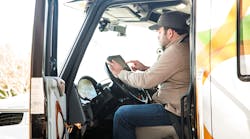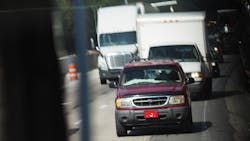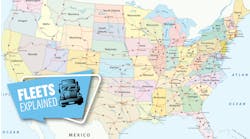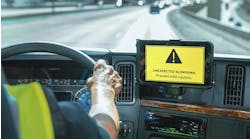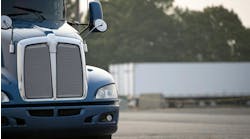To get distracted is human — and there are so many possible things to do in a vehicle today besides actually driving it. All of them can lead to huge costs and losses. How do you solve this problem that only seems to be getting worse? You could start with this: there's technology to save us from the technology that distracts us, but it's far more than that.
That's because drivers aren't only getting distracted with smartphones, GPS settings, infotainment systems or other tech items in their vehicles, although those are a large source of distraction. A driver might just be having a bad day or zone out and their mind drifts onto something other than the task that should be at hand.
"What people may not realize about distraction is just that literally, your mind is wandering," said Lauren Domnick, senior director of analytics and modeling at fleet management systems company Omnitracs. "It could be something like having family issues at home or being on the road and needing to be home for something going on there."
Fleets have been using vehicle data for more than a decade to identify adverse events in their trucks such as hard braking and acceleration, and analytics and fleet management tools can couple those events with driver coaching or use them to trigger devices such as video cameras. But more proactively, data can also help predict at-risk situations for collisions or drivers being distracted or fatigued.
Omnitracs, for example, has been using data analytics in transportation since 2004, but in 2016 added a specific module in its web-based Driving Center tool that's designed to detect things like distraction and fatigue to predict when drivers are at risk of getting into a severe accident. It exclusively uses the commercial driver's hours of service data.
The tool looks for anomalous situations that place a driver at higher risk. "Let's say that typically, I start my day at 8 a.m., and today I'm starting at 4 a.m.," Domnick explained, giving an example of a potential risk indicator. "Other things include not having enough rest at night. It can be anything from sleep opportunity to driving during high-traffic times or during hours such as the mid-afternoon, when a lot of people have that mid-afternoon 'dip' after lunch."
There are more such things within a driver's hours of service data than fleets may realize — Omnitracs has identified more than 1,000 variables that factor into its accident severity model. But that's not the only data that can be helpful in detecting and predicting driver distraction.
Data analytics firm Zendrive uses information from smartphones — one of the biggest distracted driving culprits — to predict driver risk for fleets and insurers. The company cited a University of Illinois study that found smartphone data and sensors can paint an accurate picture of that risk.
"Better data and advances in machine learning and AI [artificial intelligence] are pushing the industry forward," wrote Jonathan Matus, the company's founder and CEO. "Now, we can do much more to predict collisions and prevent future crashes on a per-driver basis."
High costs
There's obvious cause for fleets to take action on distracted driving. One of the problems police and insurance companies have noted about distracted driving-related crashes is that they can be more severe than other causes, and that's in terms of costly damage to vehicles and injuries that passengers sustain.
A drunk or similarly impaired driver, for example, may well not react quickly or adequately enough in operating a vehicle, but may at least steer, apply the brakes, or try to take some corrective action before a collision. A distracted driver might be focused entirely on something else other than the road ahead, perhaps looking down at a smartphone, and can ram into a crash without slowing or trying to avert it in the least.
Beyond collisions and related damage and losses, distracted driving can also mean big delays for a fleet. Police officers are looking for that telltale sign of drivers looking down or away from the road, and it can mean getting pulled over and ticketed and perhaps going through a roadside inspection — all of which mean delays.
More businesses that have company cars of any kind are taking steps to prevent distracted driving, recognizing the serious problem it has become. That's because for them, "the vehicle is the employer workplace," noted David Coleman, vice president of strategy and market development at Cellcontrol. The company has an app that can be installed along with a proximity-sensing device to automatically hold calls, texts and email, for instance, whenever a driver's smartphone is inside a vehicle and the vehicle is moving.
"What we're seeing is that employers are taking a very strong standpoint that 'It's our workplace and it's our responsibility to control the addiction to mobile devices that are brought into our workplace,'" Coleman said.
Doing something
It's not enough to detect distracted driving, of course — the key is to correct it and prevent it. Omnitracs' Domnick explained that the company's accident severity model can produce alerts for a driver's manager if it detects there's a high-risk situation.
"There are coaching tools. Typically, the manager will reach out to the driver and say, 'I'd like to have a conversation with you,'" she told Fleet Owner. "It's a proactive, positive conversation and is non-transactional: 'How are you?' 'Is anything bothering you?' 'Is there anything I can help you with?'"
It's key for the driver's manager to reach out and determine what stressors may be causing problems for the driver, she added, but it's a two-way street. Maybe the fleet needs to make adjustments to its scheduling.
"Listen if the driver says something to the effect of, 'Hey, you promised me I was going to get home last week, and I didn't,'" Domnick noted. "The manager needs to make sure that next time, they get that driver home, or whatever it may be that put a stressor in that driver's life."
Driver-coaching tools are also being automated as part of fleet management systems, as is the case with in-cab video-monitoring systems from companies like PeopleNet, Smartdrive and others. Just this week, Netradyne, maker of a vision-based commercial driver monitoring system, announced Driveri RealTimeCoach, which provides audible reminders and notifications when it detects risky situations.
"Technology is serving as an advocate for drivers by ensuring safe driving throughout the day," Netradyne stated in its release on the new product.
And fleets and trucking companies are investing in these technologies, not only to improve roadway safety but to help prevent the massive costs and damage to company image associated with collisions.
Anheuser Busch InBev, for example, a member of the Together for Safer Roads coalition and the world's largest beer brewing company, spends $7 million each year on telematics-based fleet safety systems to monitor speed and aggressive driving, improving safe driving practices.
Distracted driving may be a bigger risk than fleets realize in that drivers may not even aware of it. Joel Heller, team leader for the residential business at Atlanta-based HVAC company Estes Services, noted his surprise at his own risky driving behaviors when Estes installed Cellcontrol's product after experiencing too many crashes attributable to company drivers.
"I put one in my personal vehicle myself. I was just blown away," Heller said. "I realized very quickly how dangerous of a driver I was, how distracted I was. It was really quite sobering." He recalled driving in one day and talking to Estes' owner about a billboard he'd noticed.
"He told me it had been up for three months," Heller noted. "I didn't even see the billboards on a road that I travel at least twice a day" because he was using his smartphone while driving. "I needed something more; I needed to protect myself from myself, as dramatic as that sounds," he said.
More pervasive
Heller isn't alone — studies are indicating that distracted driving is getting more and more common. As technology and mobile devices are being used to do more things in our lives, that subconscious phenomenon may be becoming almost a norm for many drivers, from the motoring public to CDL-holding professionals.
"Next time you're on the road and see an erratic driver, take a closer look when you pass," noted online services comparison company Finder in its Safe Driving Report 2018 released this month. "There's a good chance that driver's chatting on the phone, texting friends or even fatigued from a long day (or night)."
The company surveyed some 2,000 American adults and found that 44.9% of drivers admit to chatting on their phones while behind the wheel in the last year — and that's only the ones that fessed up. Finder estimated that more than 18% of drivers feel fatigued and more than 16% admit to texting while driving.
In another study just released and marking 100 billion roadway miles analyzed, Zendrive found that 60% of drivers on America's roadways use their phones while driving at least once a day. At any given hour, an average of 40% of drivers pick up that phone at least once and use it, according to the company.
"69 million drivers use their phones behind the wheel every day, far higher than the 660,000 daily distracted drivers reported by government data," the study authors wrote. "We also know that we really shouldn't be playing with our phones while driving, as it contributes to 26% of all collisions."
And that's only distractions from cell phones. Thus, for a fleet or trucking company, the impetus is clear: distracted driving may be a factor in more than one out of four of your vehicles' crashes that are the fault of your drivers.
